#bay of baiae
Text
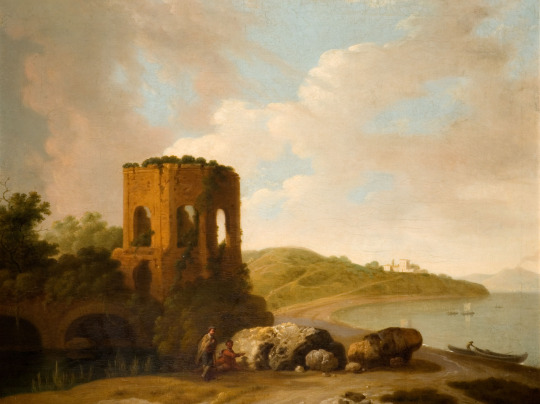
William Marlow, attributed (English, 1740-1813)
The Temple Of Venus, Bay Of Baiae, 1800
Birmingham Museums Trust
#if you are so kind please buy me a coffee#a hungry artist and blogger#link in page#William Marlow#art#the temple of venus#bay of baiae#1800s#fine art#european art#classical art#europe#european#fine arts#oil painting#europa#island kingdom#english#english art#england#landscape#landscape art#painting#roman coast#southern europe#cradle of civilization#roman empire#ruins#mediterranean
203 notes
·
View notes
Text
if anyone called me sam/e/yel i would cry. it’s sam/i/el…..
3 notes
·
View notes
Text
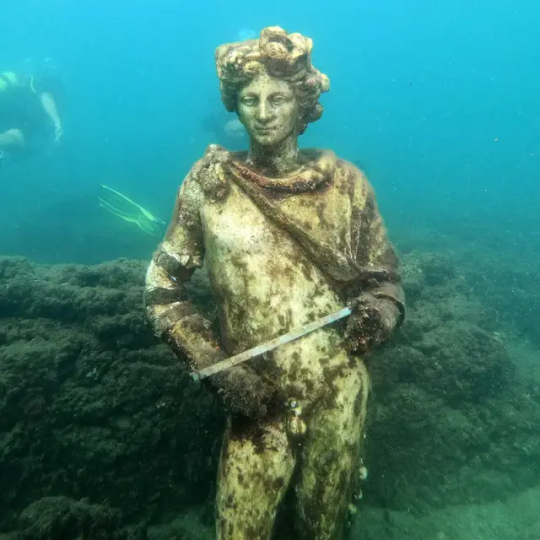

Two of several sculptures from an imperial Roman Villa from 1st century, in the submerged city of Baiae.
The ancient city of Baiae, on the Gulf of Naples, was a favorite vacation spot of the Roman aristocracy since the time of the Republic. Julius Caesar, Marcus Licinius Crassus and Pompey the Great, members of the unofficial coalition named Triumvirate, stayed in its sumptuous villas. Pompey built his villa at the highest part of the coast.
In the 16th century, seismic activity increased, sinking more than half of the city under the shallow waters of the bay.
193 notes
·
View notes
Text

Title: The Bay of Baiae, with Apollo and the Sibyl
Artist: Joseph Mallord William Turner
Date: 1823
Style: Romanticism
Genre: Mythological Painting
14 notes
·
View notes
Text
Ode to the West Wind
BY PERCY BYSSHE SHELLEY
I
O wild West Wind, thou breath of Autumn's being,
Thou, from whose unseen presence the leaves dead
Are driven, like ghosts from an enchanter fleeing,
Yellow, and black, and pale, and hectic red,
Pestilence-stricken multitudes: O thou,
Who chariotest to their dark wintry bed
The winged seeds, where they lie cold and low,
Each like a corpse within its grave, until
Thine azure sister of the Spring shall blow
Her clarion o'er the dreaming earth, and fill
(Driving sweet buds like flocks to feed in air)
With living hues and odours plain and hill:
Wild Spirit, which art moving everywhere;
Destroyer and preserver; hear, oh hear!
II
Thou on whose stream, mid the steep sky's commotion,
Loose clouds like earth's decaying leaves are shed,
Shook from the tangled boughs of Heaven and Ocean,
Angels of rain and lightning: there are spread
On the blue surface of thine aëry surge,
Like the bright hair uplifted from the head
Of some fierce Maenad, even from the dim verge
Of the horizon to the zenith's height,
The locks of the approaching storm. Thou dirge
Of the dying year, to which this closing night
Will be the dome of a vast sepulchre,
Vaulted with all thy congregated might
Of vapours, from whose solid atmosphere
Black rain, and fire, and hail will burst: oh hear!
III
Thou who didst waken from his summer dreams
The blue Mediterranean, where he lay,
Lull'd by the coil of his crystalline streams,
Beside a pumice isle in Baiae's bay,
And saw in sleep old palaces and towers
Quivering within the wave's intenser day,
All overgrown with azure moss and flowers
So sweet, the sense faints picturing them! Thou
For whose path the Atlantic's level powers
Cleave themselves into chasms, while far below
The sea-blooms and the oozy woods which wear
The sapless foliage of the ocean, know
Thy voice, and suddenly grow gray with fear,
And tremble and despoil themselves: oh hear!
IV
If I were a dead leaf thou mightest bear;
If I were a swift cloud to fly with thee;
A wave to pant beneath thy power, and share
The impulse of thy strength, only less free
Than thou, O uncontrollable! If even
I were as in my boyhood, and could be
The comrade of thy wanderings over Heaven,
As then, when to outstrip thy skiey speed
Scarce seem'd a vision; I would ne'er have striven
As thus with thee in prayer in my sore need.
Oh, lift me as a wave, a leaf, a cloud!
I fall upon the thorns of life! I bleed!
A heavy weight of hours has chain'd and bow'd
One too like thee: tameless, and swift, and proud.
V
Make me thy lyre, even as the forest is:
What if my leaves are falling like its own!
The tumult of thy mighty harmonies
Will take from both a deep, autumnal tone,
Sweet though in sadness. Be thou, Spirit fierce,
My spirit! Be thou me, impetuous one!
Drive my dead thoughts over the universe
Like wither'd leaves to quicken a new birth!
And, by the incantation of this verse,
Scatter, as from an unextinguish'd hearth
Ashes and sparks, my words among mankind!
Be through my lips to unawaken'd earth
The trumpet of a prophecy! O Wind,
If Winter comes, can Spring be far behind?
2 notes
·
View notes
Text
Since the Castel Sant' Angelo was, originally, Hadrian's tomb, he should have the last word.
0 notes
Text
Romanticismo
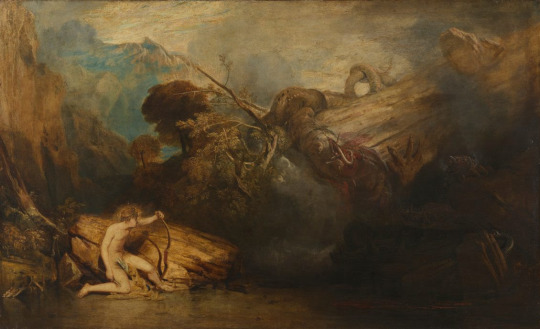
Joseph Mallord William Turner (1775-1851, England) | Apollo Kills the Python, 1811
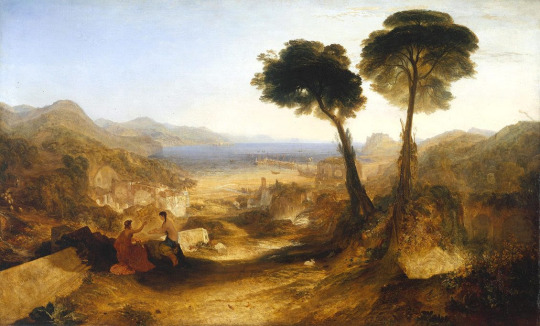
Joseph Mallord William Turner (1775-1851, England) | The Bay of Baiae with Apollo and the Sibyl, 1823
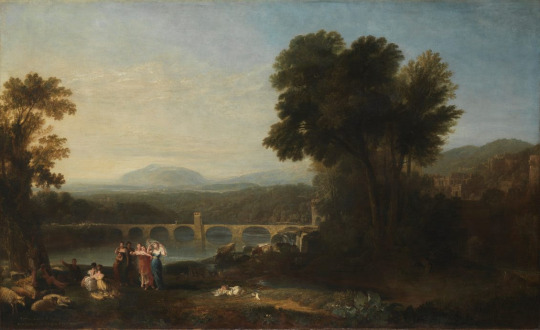
Joseph Mallord William Turner (1775-1851, England) | Apulia in Search of Apulo, 1814

Joseph Mallord William Turner (1775-1851, England) | Apollo e Dafne, 1837
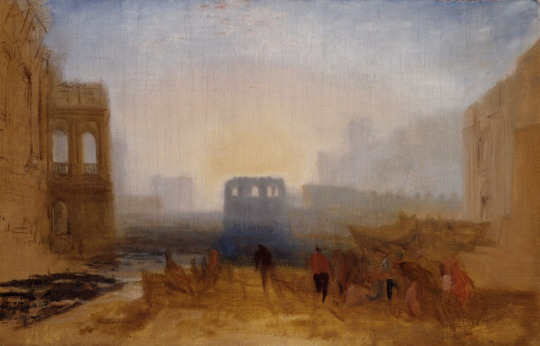
Joseph Mallord William Turner (1775-1851, England) | Study, Port Scene, 1827-28

John Constable (1776-1837, England) | The Hay Wain (Il Carro di Fieno), 1821 (London, National Gallery)
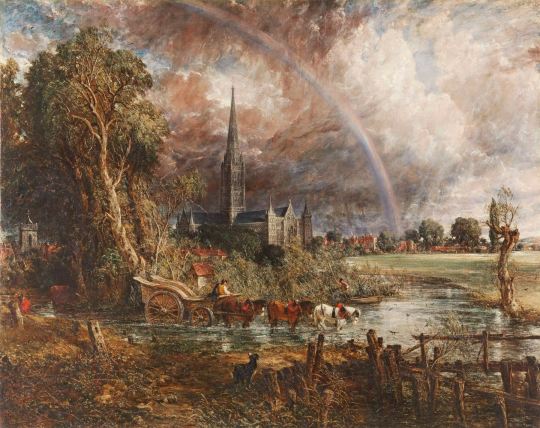
John Constable (1776-1837, England) | Salisbury Cathedral, 1831 (London, Tate)

Théodore Géricault (1791-1824, France) | La Zattera della Medusa, 1819 (Paris, Louvre)

Caspar David Friedrich (1774-1840, Germany) | Viandante sul Mare di Nebbia, 1818 (Hamburger Kunsthalle)

Canaletto (1697-1768, Italia) | L’arrivo dell’Ambasciatore francesce Jacques-Vincente Languet, Comte de Gergy, Palazzo Ducale, Venezia, 5 novembre 1726, 1726-27
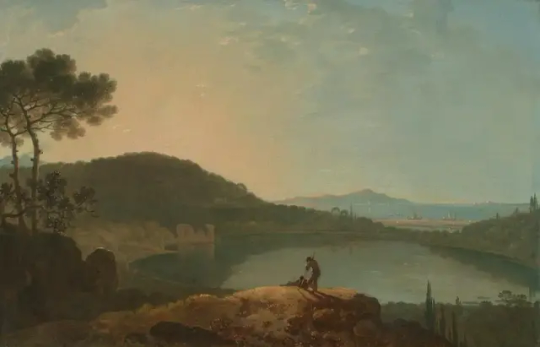
Il Lago d’Averno, 1760 ca. (London, Tate) | Richard Wilson (1714-1782, Galles)
1 note
·
View note
Text
Turner, Paesaggi della Mitologia a Venaria Reale
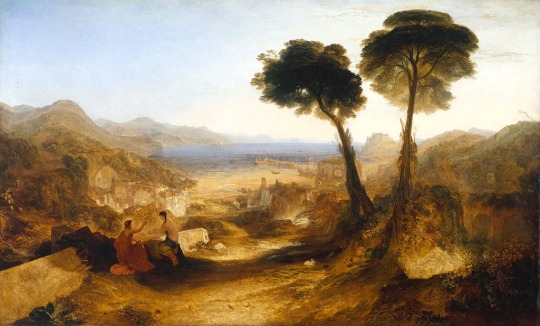
Fino al 28 gennaio 2024 la Reggia di Venaria propone la mostra Turner. Paesaggi della Mitologia, a cura della storica dell’arte inglese Anne Lyles, continuando così la prestigiosa collaborazione con la Tate UK dopo la mostra che si è tenuta nel 2022 dedicata a John Constable.
L’esposizione si trova al primo piano delle Sale delle Arti e presenta una selezione di una quarantina di opere provenienti dalla prestigiosa istituzione britannica, nelle quali Turner esprime non solo la sua passione per la pittura di paesaggio, ma anche quella per temi legati alla mitologia classica greca e romana.
Nelle dieci sale della mostra i visitatori trovano sia i grandi dipinti a olio su tela, realizzati da Turner per essere esposti alla Royal Academy di Londra, sia gli acquerelli e gli schizzi in cui l’artista manifestò con libertà e spontaneità la sua visione romantica della Natura e del Mito.
Tra gli artisti britannici più noti e amati, William Turner fu celebre per i suoi paesaggi, dove la Natura è concepita nell’ambito di una estetica del Sublime, con fitte nebbie, tempeste di mare e fenomeni naturali che incutono timore all’uomo e al contempo attraggono.
Ma Turner si affermò a livello internazionale all’inizio dell’Ottocento dipingendo grandi quadri per le grandi rassegne ufficiali, con scene tratte dalla Bibbia, dalla letteratura classica e dalla mitologia ancora influenzati dallo stile dei suoi predecessori francesi, come Nicolas Poussin e Claude Lorrain, oltre ai personaggi che popolano il mondo della mitologia, dopo che ebbe studiato da vicino alla National Gallery di Londra i dipinti degli Old Masters.
Inoltre, durante i primi anni da studente della Royal Academy, l’artista imparò a riprodurre fedelmente, a matita o a gessetto, i calchi delle più celebri statue del mondo classico, come l’Apollo del Belvedere.
A influenzare ulteriormente i quadri di mitologia classica di Turner contribuì Richard Wilson, che nella seconda metà del Settecento visse per un lungo periodo nel sud Italia, tra Roma e Napoli, dove le sue tele erano popolate da figure della classicità o mitologiche, in paesaggi idealizzati, ma influenzati da luoghi reali che aveva visitato.
Il desiderio di Turner di conoscere i paesaggi italiani di Wilson si realizzò nel 1819, per le difficoltà che comportava un viaggio in Europa durante le guerre napoleoniche.
In Italia Turner tornò poi nel 1828 per un soggiorno più lungo e da allora usò proprio i paesaggi italiani come sfondo per i soggetti mitologici.
Alcune opere della mostra, come The Bay of Baiae with Apollo and the Sibyl (1823), documentano come il soggetto mitologico fosse trattato da Turner con sempre più dettaglio e consapevolezza storica. Lo sfondo di rovine romane e la figura della Sibilla Cumana simboleggiano i temi che l’artista aveva più a cuore tra bellezza e decadenza, gloria e declino, fragilità della vita e caduta degli imperi.
Read the full article
0 notes
Text
Events 7.10 (before 1900)
138 – Emperor Hadrian of Rome dies of heart failure at his residence on the bay of Naples, Baiae; he is buried at Rome in the Tomb of Hadrian beside his late wife, Vibia Sabina.
645 – Isshi Incident: Prince Naka-no-Ōe and Fujiwara no Kamatari assassinate Soga no Iruka during a coup d'état at the imperial palace.
988 – The Norse King Glúniairn recognises Máel Sechnaill mac Domnaill, High King of Ireland, and agrees to pay taxes and accept Brehon Law; the event is considered to be the founding of the city of Dublin.
1086 – King Canute IV of Denmark is killed by rebellious peasants.
1212 – The most severe of several early fires of London burns most of the city to the ground.
1460 – Richard Neville, 16th Earl of Warwick, defeats the king's Lancastrian forces and takes King Henry VI prisoner in the Battle of Northampton.
1499 – The Portuguese explorer Nicolau Coelho returns to Lisbon after discovering the sea route to India as a companion of Vasco da Gama.
1512 – The Spanish conquest of Iberian Navarre commences with the capture of Goizueta.
1519 – Zhu Chenhao declares the Ming dynasty's Zhengde Emperor a usurper, beginning the Prince of Ning rebellion, and leads his army north in an attempt to capture Nanjing.
1553 – Lady Jane Grey takes the throne of England.
1584 – William I of Orange is assassinated in his home in Delft, Holland, by Balthasar Gérard.
1645 – English Civil War: The Battle of Langport takes place.
1778 – American Revolution: Louis XVI of France declares war on the Kingdom of Great Britain.
1789 – Alexander Mackenzie reaches the Mackenzie River delta.
1806 – The Vellore Mutiny is the first instance of a mutiny by Indian sepoys against the British East India Company.
1832 – U.S. President Andrew Jackson vetoes a bill that would re-charter the Second Bank of the United States.
1850 – U.S. President Millard Fillmore is sworn in, a day after becoming president upon Zachary Taylor's death.
1877 – The then-villa of Mayagüez, Puerto Rico, formally receives its city charter from the Royal Crown of Spain.
1882 – War of the Pacific: Chile suffers its last military defeat in the Battle of La Concepción when a garrison of 77 men is annihilated by a 1,300-strong Peruvian force, many of them armed with spears.
1883 – War of the Pacific: Chileans led by Alejandro Gorostiaga defeat Andrés Avelino Cáceres's Peruvian army at the Battle of Huamachuco, hastening the end of the war.
1890 – Wyoming is admitted as the 44th U.S. state.
0 notes
Text
Ode to the West Wind
By Percy Bysshe Shelley
I
O wild West Wind, thou breath of Autumn's being,
Thou, from whose unseen presence the leaves dead
Are driven, like ghosts from an enchanter fleeing,
Yellow, and black, and pale, and hectic red,
Pestilence-stricken multitudes: O thou,
Who chariotest to their dark wintry bed
The winged seeds, where they lie cold and low,
Each like a corpse within its grave, until
Thine azure sister of the Spring shall blow
Her clarion o'er the dreaming earth, and fill
(Driving sweet buds like flocks to feed in air)
With living hues and odours plain and hill:
Wild Spirit, which art moving everywhere;
Destroyer and preserver; hear, oh hear!
II
Thou on whose stream, mid the steep sky's commotion,
Loose clouds like earth's decaying leaves are shed,
Shook from the tangled boughs of Heaven and Ocean,
Angels of rain and lightning: there are spread
On the blue surface of thine aëry surge,
Like the bright hair uplifted from the head
Of some fierce Maenad, even from the dim verge
Of the horizon to the zenith's height,
The locks of the approaching storm. Thou dirge
Of the dying year, to which this closing night
Will be the dome of a vast sepulchre,
Vaulted with all thy congregated might
Of vapours, from whose solid atmosphere
Black rain, and fire, and hail will burst: oh hear!
III
Thou who didst waken from his summer dreams
The blue Mediterranean, where he lay,
Lull'd by the coil of his crystalline streams,
Beside a pumice isle in Baiae's bay,
And saw in sleep old palaces and towers
Quivering within the wave's intenser day,
All overgrown with azure moss and flowers
So sweet, the sense faints picturing them! Thou
For whose path the Atlantic's level powers
Cleave themselves into chasms, while far below
The sea-blooms and the oozy woods which wear
The sapless foliage of the ocean, know
Thy voice, and suddenly grow gray with fear,
And tremble and despoil themselves: oh hear!
IV
If I were a dead leaf thou mightest bear;
If I were a swift cloud to fly with thee;
A wave to pant beneath thy power, and share
The impulse of thy strength, only less free
Than thou, O uncontrollable! If even
I were as in my boyhood, and could be
The comrade of thy wanderings over Heaven,
As then, when to outstrip thy skiey speed
Scarce seem'd a vision; I would ne'er have striven
As thus with thee in prayer in my sore need.
Oh, lift me as a wave, a leaf, a cloud!
I fall upon the thorns of life! I bleed!
A heavy weight of hours has chain'd and bow'd
One too like thee: tameless, and swift, and proud.
V
Make me thy lyre, even as the forest is:
What if my leaves are falling like its own!
The tumult of thy mighty harmonies
Will take from both a deep, autumnal tone,
Sweet though in sadness. Be thou, Spirit fierce,
My spirit! Be thou me, impetuous one!
Drive my dead thoughts over the universe
Like wither'd leaves to quicken a new birth!
And, by the incantation of this verse,
Scatter, as from an unextinguish'd hearth
Ashes and sparks, my words among mankind!
Be through my lips to unawaken'd earth
The trumpet of a prophecy! O Wind,
If Winter comes, can Spring be far behind?
0 notes
Text
yes my interest in historical figures revolves nearly entirely around how funny the things they did in their lifetime were
#talk#the bay of baiae caligula antic was in fact hysterical. Waste of resources? No. Respect a man who knows how to commit to the bit.
9 notes
·
View notes
Photo





Discoveries in the submerged Roman city of Baiae.
Marble mosaic flooring: Vestiges of the mosaic recently discovered in the submerged city of Baiae. Photo: Archaeological Park of the Phlegrean and Naumacos Fields.
Submerged statue: An underwater archaeologist looks at one of the submerged statues that once graced a Roman villa in the coastal city of Baiae . Photo: Antonio Busiello.
Rescued statue. Divers extract from the sea, in 1969, the statue of one of the companions of the hero Odysseus, who carries a wineskin with wine to get the Cyclops Polyphemus drunk. This piece was part of a sculptural group. Photo: Paul Fearn / Alamy / ACI.
The god Dionysus. Statue of the god of wine from the nymphaeum or monumental fountain of Baiae. Archaeological Museum of the Phlegrean Fields. Photo: DEA / Album.
Meticulous restoration: Specialists clean and restore one of the statues recovered from the underwater site. Photo: Jonathan Blair / Getty images.
On the Gulf of Naples, near Pompeii, stood the city of Baiae , a seaside resort where the rich and powerful of Rome vacationed, drawn by its thermal springs and hedonistic lifestyle. Thus, Baiae ended up becoming one of the favorite vacation spots of the Roman aristocracy. Characters such as the immensely rich Marco Licinio Craso, Pompey the Great, and Julius Caesar, who built his villa in the highest part of the coast, stayed in its sumptuous villas.
Much later, this luxurious holiday resort was looted during invasions by barbarian peoples and abandoned after an Arab attack in the 8th century. But, in addition, Baiae was located on a very active volcanic area and in the 16th century seismic activity increased which ended up sinking more than half of the city under the waters of little deep in the bay.
In 2013, Baiae was the scene of other archaeological excavations. A marble statue depicting Apollo, the Greek god of the arts, has been discovered and restored by the Central Institute for Restoration in Rome. It is expected that the sculpture will return to Baiae very soon, where it will be exhibited in the rooms of the Archaeological Museum of the Phlegrean Fields of the Aragonese Castle.
From an article by J. M. Sadurní, specialist in historical news.
National Geographic/Spain -April 13, 2023
560 notes
·
View notes
Text
i learned that an ancient Roman oracle once prophesied that "Caligula had no more chance of becoming emperor than of riding a horse across the Bay of Baiae". After becoming emperor, Caligula ordered ships to construct the largest pontoon bridge in history, and rode his horse across the Bay of Baiae. (x)
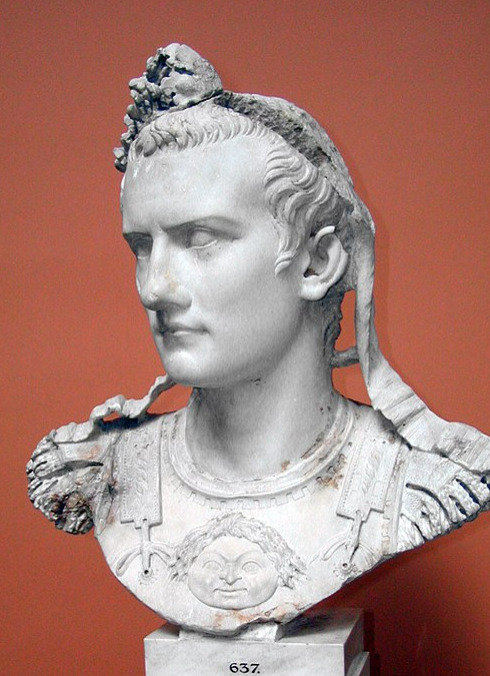
688 notes
·
View notes
Photo
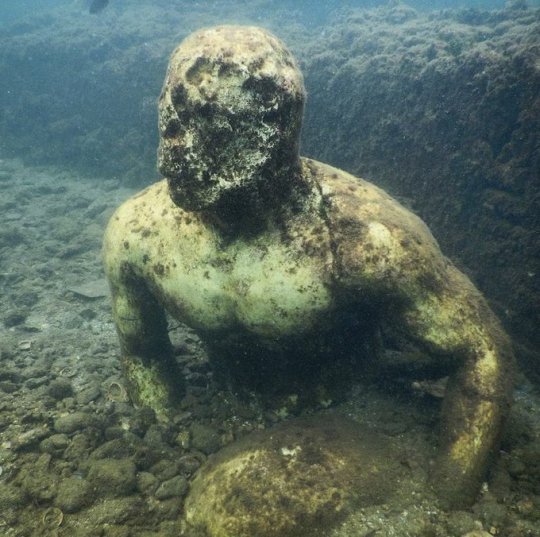
Underwater Archeology, 100 AD ca, Ruins of the Old Roman City Baiae, Bay of Naples, Campania, Italy. An Amazing Figure of a Roman Sculpture representing one of the companions of the hero Ulysses, holding a set of Leather wines.
68 notes
·
View notes
Photo

The Bay of Baiae, with Apollo and the Sibyl, 1823, William Turner
Medium: oil,canvas
https://www.wikiart.org/en/william-turner/the-bay-of-baiae-with-apollo-and-the-sibyl
15 notes
·
View notes
Photo

Thomas Jones: An Imaginary Landscape with a Traveller and Figures Overlooking the Bay of Baiae, 1773
#Thomas Jones#An Imaginary Landscape with a Traveller and Figures Overlooking the Bay of Baiae#Oil on Canvas#Painting#Art#Romanticism#British Romanticism
1 note
·
View note